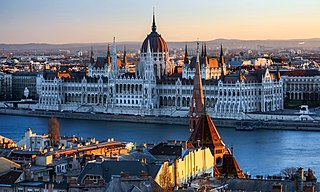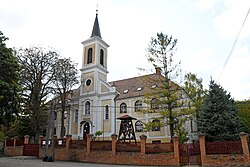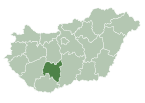
Austria-Hungary, often referred to as the Austro-Hungarian Empire or the Dual Monarchy, was a multi-national constitutional monarchy in Central Europe between 1867 and 1918. Austria-Hungary was a military and diplomatic alliance of two sovereign states with a single monarch who was titled both emperor of Austria and King of Hungary. Austria-Hungary constituted the last phase in the constitutional evolution of the Habsburg monarchy: it was formed with the Austro-Hungarian Compromise of 1867 in the aftermath of the Austro-Prussian War and was dissolved shortly after Hungary terminated the union with Austria on 31 October 1918.

Hungary is a landlocked country in Central Europe. Spanning 93,030 square kilometres (35,920 sq mi) of the Carpathian Basin, it is bordered by Slovakia to the north, Ukraine to the northeast, Romania to the east and southeast, Serbia to the south, Croatia and Slovenia to the southwest, and Austria to the west. Hungary has a population of 9.5 million, mostly ethnic Hungarians and a significant Romani minority. Hungarian is the official language, and Budapest is the country's capital and largest city.

Hungarian is a Uralic language spoken in Hungary and parts of several neighbouring countries that used to belong to it. It is the official language of Hungary and one of the 24 official languages of the European Union. Outside Hungary, it is also spoken by Hungarian communities in southern Slovakia, western Ukraine (Subcarpathia), central and western Romania (Transylvania), northern Serbia (Vojvodina), northern Croatia, northeastern Slovenia (Prekmurje), and eastern Austria.

Transylvania is a historical and cultural region in Central Europe, encompassing central Romania. To the east and south its natural border is the Carpathian Mountains and to the west the Apuseni Mountains. Broader definitions of Transylvania also include the western and northwestern Romanian regions of Crișana and Maramureș, and occasionally Banat. Historical Transylvania also includes small parts of neighbouring Western Moldavia and even a small part of south-western neighbouring Bukovina to its north east. The capital of the region is Cluj-Napoca.

Budapest is the capital and most populous city of Hungary. It is the ninth-largest city in the European Union by population within city limits and the largest city on the Danube river; the city has an estimated population of 1,752,286 over a land area of about 525 square kilometres. Budapest, which is both a city and county, forms the centre of the Budapest metropolitan area, which has an area of 7,626 square kilometres and a population of 3,303,786. It is a primate city, constituting 33% of the population of Hungary.

Tolna is an administrative county in present-day Hungary as it was in the former Kingdom of Hungary. It lies in central Hungary, on the west bank of the river Danube. It shares borders with the Hungarian counties of Somogy, Fejér, Bács-Kiskun, and Baranya. The capital of Tolna county is Szekszárd. Its area is 3,703 km2.

Hungarians in Serbia are a recognized national minority in Serbia. According to the 2022 census, the population of ethnic Hungarians in Serbia is 184,442, constituting 2.8% of the total population, which makes them the second-largest ethnic group in the country behind Serbs and the largest minority group. The vast majority of them live in the northern autonomous province of Vojvodina, where they number 182,321 and make up 10.5% of the province's population. Almost 99% of all Hungarians in Serbia live in the province of Vojvodina. Most Hungarians in Serbia are Roman Catholics, while smaller numbers of them are Protestant. Their cultural center is located in Subotica.

The Hungary women's national water polo team represents Hungary in international women's water polo competitions and friendly matches. The team is one of the leading teams in Europe since the early 1990s, claiming the world title at the 1994 World Aquatics Championships in Rome, Italy and at the 2005 World Aquatics Championships in Montreal, Canada.
Anett Tímea Györe is a Hungarian water polo player who competed at the 2004 Summer Olympics in Athens, Greece, where she finished in sixth place with the Hungary women's national team. A year earlier she was on the side that claimed the silver medal at the European Championship in Ljubljana, Slovenia.

Hungarians, also known as Magyars, are a nation and ethnic group native to Hungary and historical Hungarian lands who share a common culture, history, ancestry, and language. The Hungarian language belongs to the Uralic language family, alongside, most notably Finnish and Estonian.

András Tibor Gerevich is a Hungarian poet, screenwriter, literary translator and Professor of Screenwriting at Budapest Metropolitan University and McDaniel College Budapest.

A Lesson in History is a 1957 joint Soviet–Bulgarian historical drama film directed by Lev Arnshtam and Hristo Piskov about Georgi Dimitrov and the Leipzig Trial.
József Györe was a Hungarian communist politician, who served as Interior Minister between 1952 and 1953.
József is a Hungarian masculine given name. It is the Hungarian name equivalent to Joseph.
Anett is a feminine given name. People bearing the name include:

The bárányles is a local tradition in the southern Hungarian village Hosszúhetény and around the Zengő mountain, a night pilgrimage on Easter Sunday, in which only males can take part.

Raul Justo Bocanegra is an American politician, and a former member of the California State Assembly. He is a Democrat who represented the 39th Assembly District, encompassing northeastern San Fernando Valley.

Bonyhád is a district in southern part of Tolna County. Bonyhád is also the name of the town where the district seat is found. The district is located in the Southern Transdanubia Statistical Region.

The Rákosi government led Hungary for nearly ten months, spanning from August 14, 1952, to July 4, 1953. It officially operated as the Council of Ministers of the Hungarian People's Republic and was helmed by Mátyás Rákosi, who served as the Secretary General of the Hungarian Workers' Party.


















